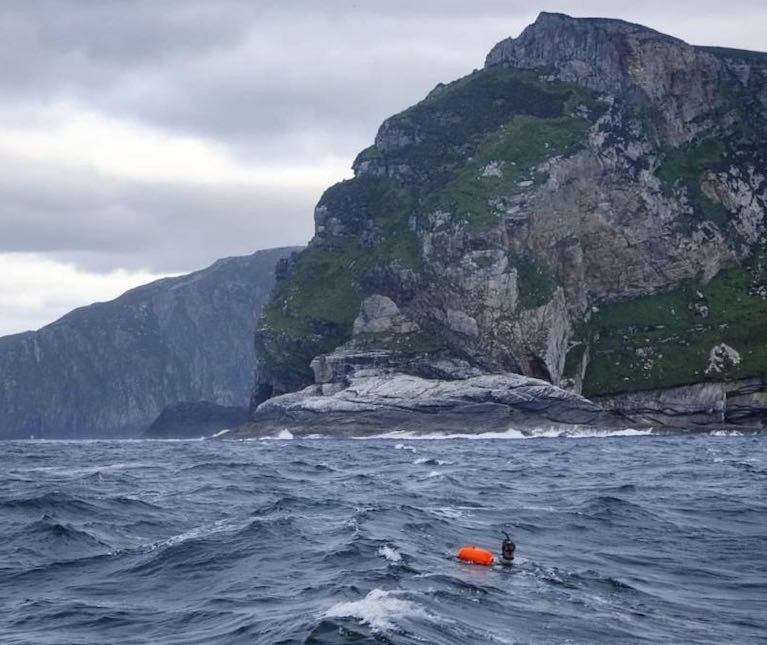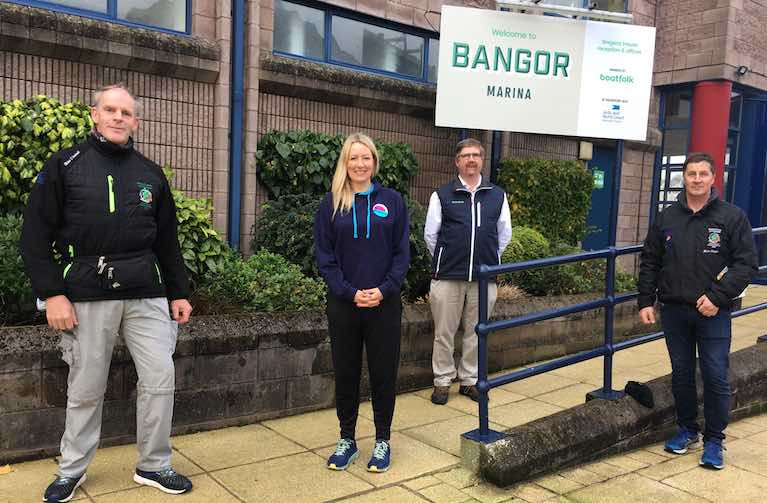Displaying items by tag: Henry O'Donnell
Sporting blue hair, painted blue eyelids and a blue wave painted on his chest, Water Safety Ireland ambassador Henry O’Donnell took to the Donegal coastline to issue a safety appeal on World Drowning Prevention day.
The former Army Ranger, lifeguard, diver and swim instructor, who recently became the first man to finswim around Ireland, invited people to “do one positive thing” to save lives.
Children under the age of five are at highest risk, he noted, with drownings often occurring during routine activities, such as bathing, collecting water for domestic use, travelling over water on boats or ferries, and fishing.
“ The impacts of seasonal or extreme weather events are also a frequent cause of drowning,”he said, and “most of these deaths are preventable with common sense low cost solutions”.
Such solutions include installing barriers controlling access to water, providing safe places away from water such as crèches for pre-school children with capable childcare, and teaching swimming, water safety and safe rescue skills, he said.
Training bystanders in safe rescue and resuscitation, setting and enforcing safe boating, shipping and ferry regulations, adopting a water safety culture and improving flood risk management are other measures, he said.
Drowning is one of the main causes of death around the world for people aged between one and 27 years of age, he noted, and more than 225,000 people drown each year globally.
Listen to Henry O'Donnell on podcast with Lorna Siggins here
Donegal-born former Army Ranger, lifeguard, diver and swim instructor Henry O’Donnell has become the first man to finswim around Ireland.
The solo swimmer completed 1,569 kilometres, equivalent to 847 nautical miles, when he landed at Carrickfin beach in the Donegal Gaeltacht on Saturday.
“We had to go for it with the weather and the sea - and when you get an opportunity you have to seize it,”he said, describing the final push over the past week.
“ I’m pretty tired, as are my expedition teams who were phenomenal and worked very hard,” O’Donnell said.
Up to 20 sea swimmers joined him for the last 400 metres into Carrickfin, where he was met by members of his family and many supporters.
Water Safety Ireland deputy chief executive Roger Sweeney and Ena Barrett of the Irish Cancer Society greeted him, along with representatives of the RNLI, Gardai and Donegal County Council.
“I see myself as a player on a very big team, and part of that were the coastal communities that gave such support,” O’Donnell said afterwards.
The father and grandfather has trekked and climbed to some of the highest and lowest points on four of the globe’s continents and led the first successful relay swim around Ireland in 2006.
He set out in September 2020 from Carrickfin - where he first learned to swim - with the aim of completing the first solo fin swim around Ireland in aid of Water Safety Ireland and the Irish Cancer Society.
He had to take a pause last year due to Covid, but he and his team are back in the water and on the last long leg up the west coast. To date, he has raised over 46,000 euro
O’Donnell noted that there was Mediterranean weather on September 17th 2020 when he first set out from north Donegal, and there were similar conditions on Saturday for his finish.
“In between, we had some very challenging conditions,”he said.
“Over the past week, I put in a few significantly long swims, with safety as number one priority,”he said.
“We had a fantastic expedition vessel along the west coast, named Macbel, which allowed us to take us straighter lines and swim further offshore,”he said.
Navigating Tory sound, Malin Head, and rounding Rathlin sound off the Antrim coast were key stages, he said, along with passing Baily lighthouse off Howth and negotiating shipping lanes in Dublin Bay.
Rounding Carnsore point off the south-east and the Fastnet rock off the south-west were also psychological highlights, he said.
“This was as challenging my most difficult expeditions, and the longest by far,”he said.
“However, hearing about loss experienced by families, and illness of young children would help you to keep going,”he said.
“ We did a tribute off the Arranmore lighthouse for all the fishermen and women lost off the Donegal coast and all others lost at sea, and we remembered the Rescue 116 helicopter crew when were off Mayo,”he said.
“We had paid similar tributes to those lost at sea when we were in Kilmore Quay, Co Wexford and on the Fastnet rock off west Cork,”he said.
“A lot changed, even after we resumed the swim – the price of fuel went up for instance, due to the Ukraine crisis,”he said.
“We didn’t see any Russian submarines, but we were protecting the coast as best we could,”he said.
Once he got a glimpse of Errigal mountain from Owey island, he said he knew he was on the home stretch, he said.
Fin Swimmer Henry O’Donnell Completes First Phase of Swim Round Ireland
Donegal man Henry O’Donnell has successfully completed the first phase of his quest to be the first person in the world to fin swim around a country.
The 'Finman' is progressing south down the Irish Sea towards Dublin.
Henry has demonstrated great tenacity and endurance so far and we wish him well for the remainder of his expedition.
Henry departed his native Carrickfinn in County Donegal on the 17th of September and has completed 412 kilometres of his passage so far, landing into Carlingford on Wednesday following 28 days in the water.
He faces a drop in water temperature as we advance into the winter, with the current water temperature at 12° Celsius. Over the duration of his expedition, he received great support and sponsorship in the North of Ireland.
His mission is to attempt to fin swim around Ireland to become the first person ever to circumnavigate a country by fin swimming and in doing so will help to raise funds for two charities, Water Safety Ireland and the Irish Cancer Society.
Henry hopes to make landfall in Howth, County Dublin late next week, between the 12th and 15th of November weather permitting.
Details of the expedition are available here
Swim Around Ireland - Donegal Man Henry O'Donnell's Attempting Clockwise Circumnavigation
There are many variations to the sport of swimming. But, long-distance swimming is on another level, and what Donegal man Henry O'Donnell is attempting at the moment he calls an Expedition. He will try to swim around the Island of Ireland to become the first person in history to circumnavigate a country by Finswimming and in doing so will help to raise funds for two National Charities, Water Safety Ireland and the Irish Cancer Society.
Finswim2020-21 is one of the most inspiring, unique, and challenging marine projects ever attempted in Irish coastal waters. Expedition Leader O'Donnell began his challenge, which he thought may take a year, from Carrickfin in the Donegal Gaeltacht, and is the creator of this pioneering project. He had thought of the idea of the circumnavigation in 1990 when he was recovering from a life-threatening sports accident (which left him paralysed for some time), and in 1992 he went on to complete several challenging land-based expeditions and sea swims to raise funds for charities and other worthy causes.
 Tor Dearg is the Finswim 2020-21 support boat Round Ireland
Tor Dearg is the Finswim 2020-21 support boat Round Ireland
He loves sport in general, healthy living and has a close affinity with the sea and nature. He completed demanding expeditions around the world in recent years including lowest to highest points on four continents; Africa, Europe, America and Australia – he is confident that finswim2020-21 will be equal or more challenging than many expeditions and adventures previously were undertaken.
The event was scheduled to start in June 2021. Still, due to the COVID crisis, work situation and other factors, it was necessary to reorganise, and Henry decided to bring the Expedition forward to 2020. So, on 17th September the 56-year-old walked into the sea at Carrickfin beach in the hope of becoming the first person to accomplish such a challenge. Fin-swimming, as the name suggests, involves the use of fins on the water surface, with a snorkel and mask. O'Donnell also wears a custom-made triathlon suit to combat icy temperatures.
Henry has many strings to his bow – a qualified beach guard, specialist diver, swimming teacher and ex Irish Army Special Forces – and then there's his day job – an aviation security advisor. And many achievements too – the first Irishman to swim the 14km around Tory Island and a 38k Donegal Coastal challenge.
It fits therefore that the supporting Expedition vessel is the Tor Dearg, the Tory Island fast ferry skippered by William Duggan with photographer and cameraman Rory O'Donnell on board to document the venture.
On the clockwise swim, Henry's passage took him to Tory Island, Downings, Glengad near Malin Head, Portrush, through the fast-flowing Rathlin Sound after a stop on Rathlin Island; Glenarm in County Antrim, then into Belfast Lough at Carrickfergus before carrying on south along the North Down coast between Copeland Island and Old Lighthouse Island off Donaghadee. It was then down the Ards Peninsula to Portavogie where he halted to take a break back in Bangor where the Tor Dearg berthed in the Marina on Monday (19th October). Harbour Master Kevin Baird welcomed them. " We are delighted to welcome and support Henry O'Donnell on his epic adventure to swim around the Island of Ireland. Henry arrived into Bangor shortly after the tragic death of local sea swimmer Mary Feeney, and it was extremely thoughtful of him to dedicate a section of his swim in her memory. We also applauded his efforts to raise money for both the Irish Cancer Society and Water Safety Ireland. We wish him every success as he continues his courageous mission". According to his Facebook page, Henry has swum between 16 and 21 miles a day.
While in County Down Henry has joined some of the local open water swim clubs – the Helen's Bay Watch, the Brompton Beaus and Belles near the Marina, and the Chunky Dunkers at Donaghadee. Henry appreciated their support. " I wish to thank all of the sea swimmers in the Bangor coastal area for the invaluable support, friendship and kindness during my swim in the beautiful but challenging north Channel. I thank Harbourmaster, Mr Kevin Baird and his team for their professional assistance and for sponsoring the expedition vessel berth during our time in Bangor. The Carrickfergus Harbour team went out of their way too in support of the charity event".
The Expedition will leave Portavogie shortly, destination Ardglass on the South Down coast, subject of course to the wind and sea state, before continuing onward south. They have an exemption from the 5km travel restriction rule in the Republic and are following strict Covid-19 guidance and regulations both ashore and onboard the Tor Dearg.
For more info, visit www.finswim2020.com.
























